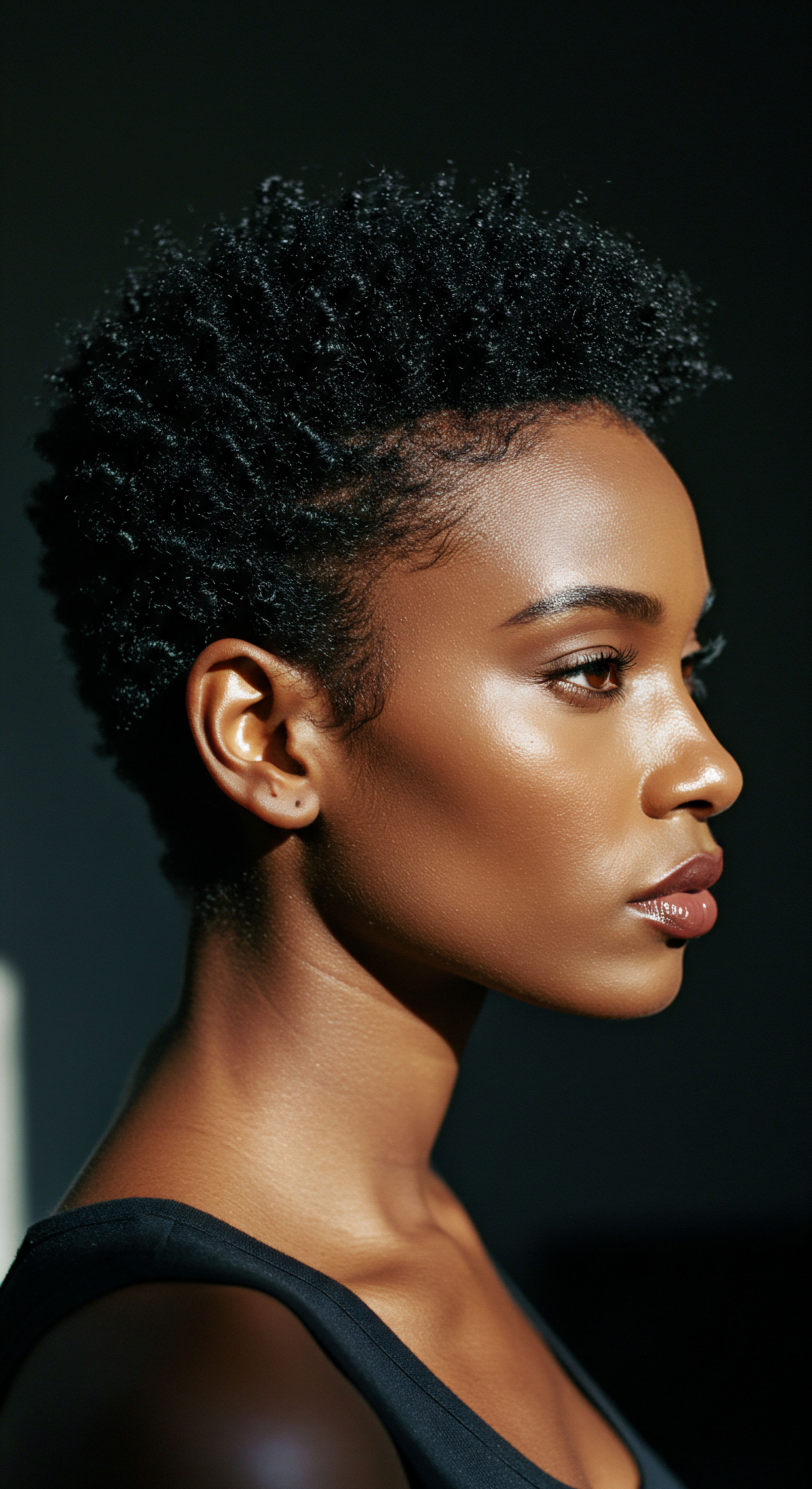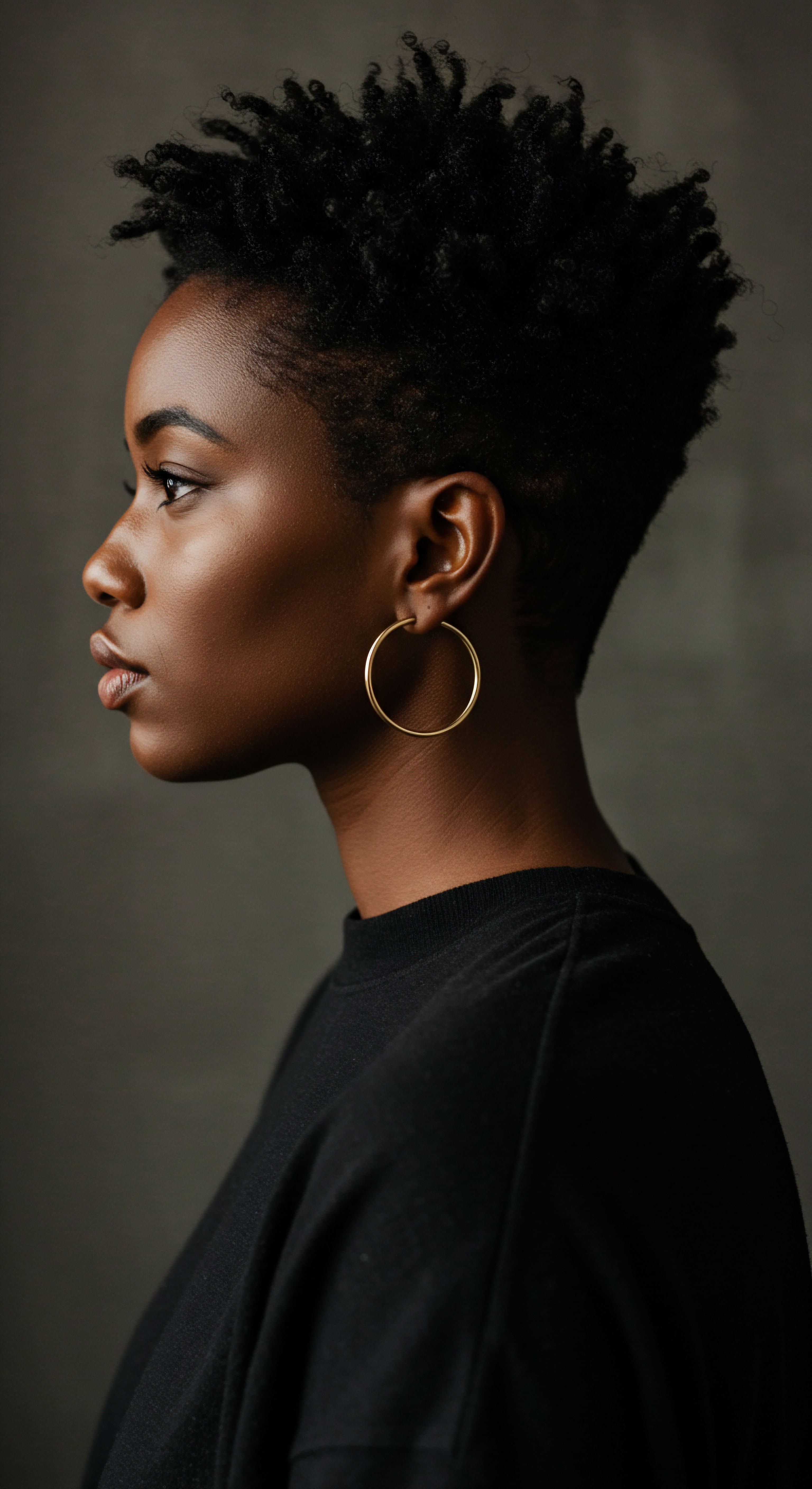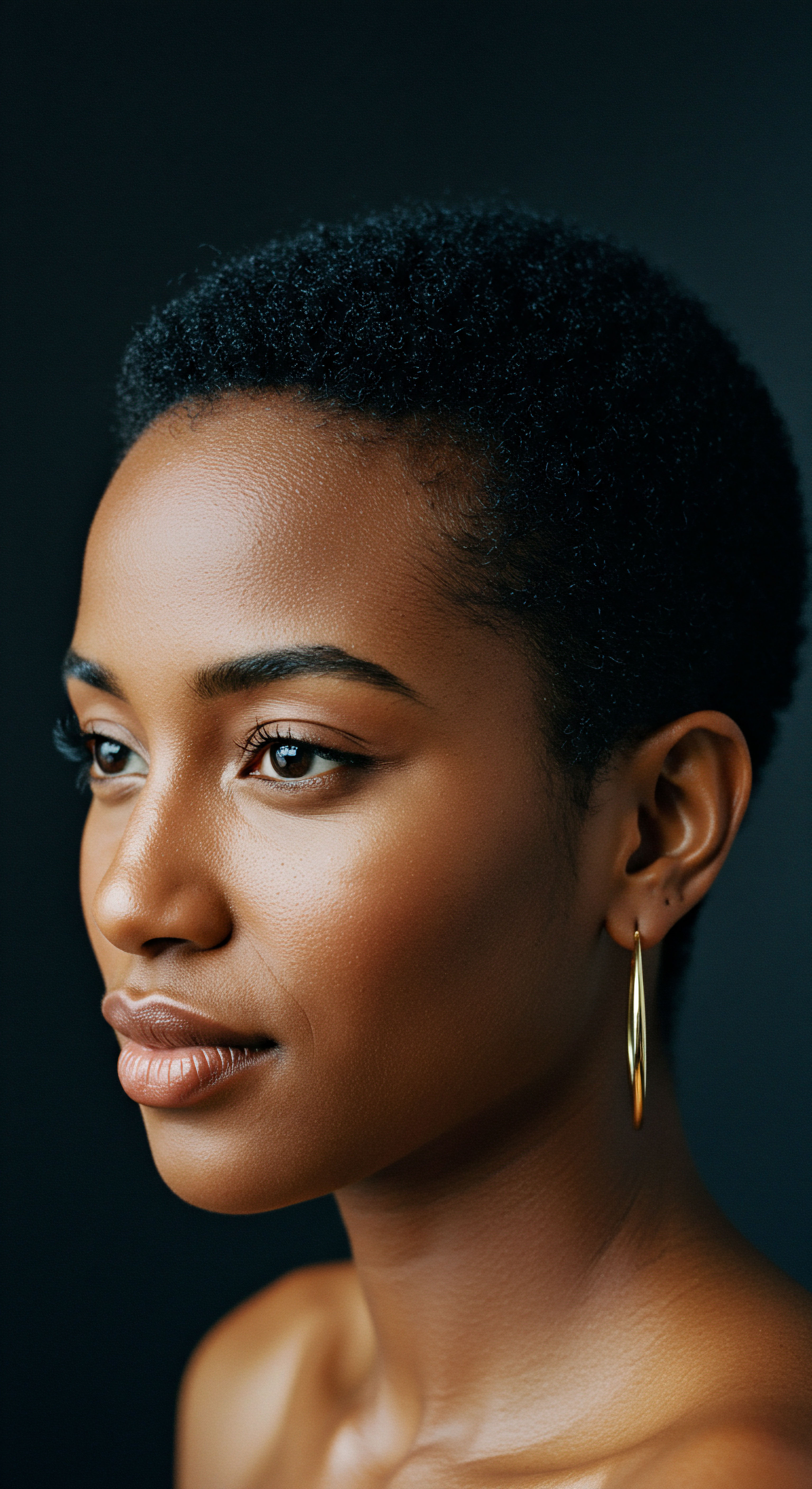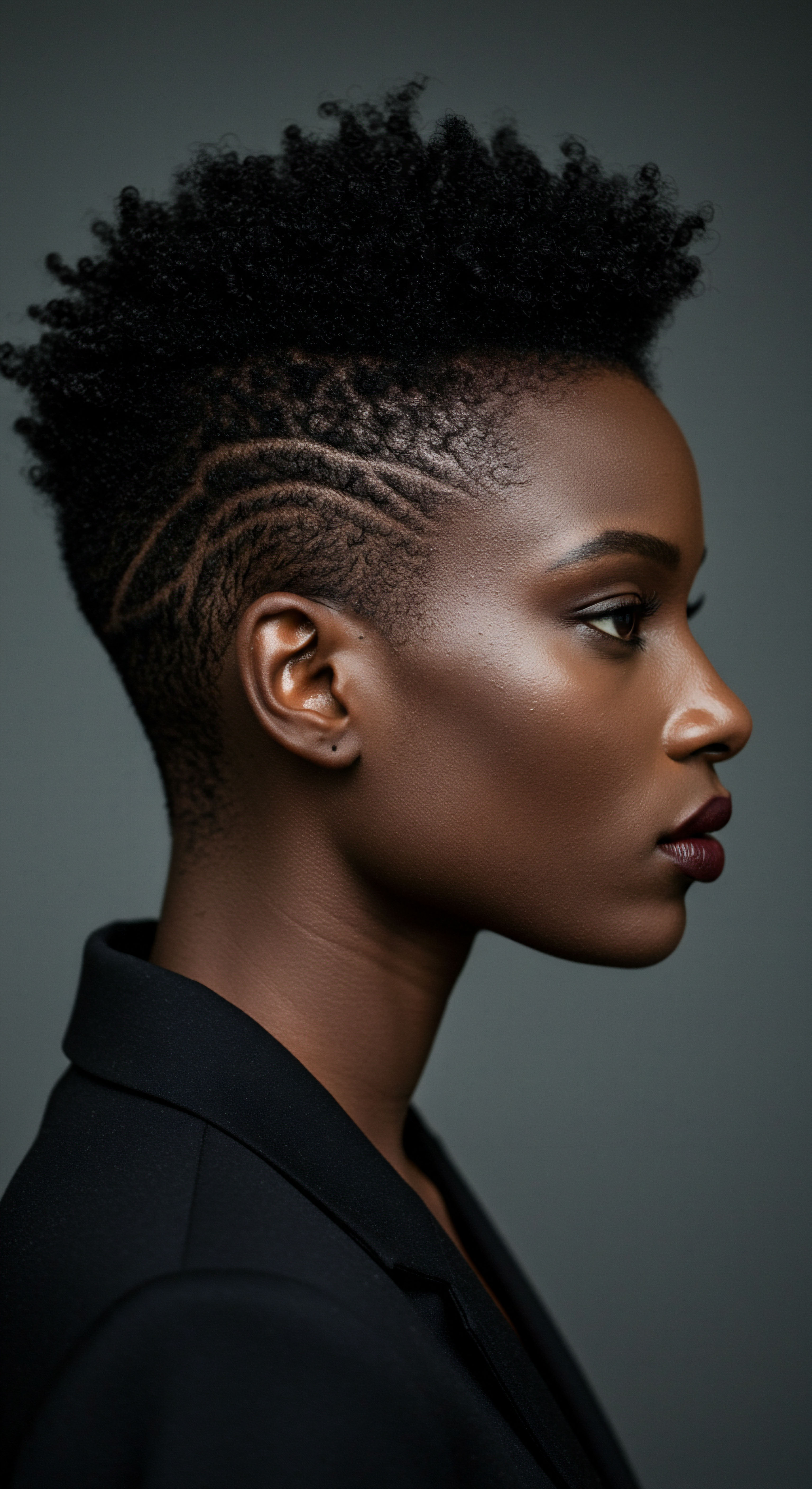
Roots
Consider the sun-drenched expanse of ancient Kemet, where the relentless desert wind sculpted dunes and painted the sky in hues of ochre and gold. In such a crucible of heat and dry air, where every drop of moisture was precious, how did the keepers of coiled crowns and delicate waves preserve their strands? This inquiry invites us beyond mere historical record, prompting us to feel the dry whisper of the desert, to sense the ingenuity born of necessity.
It is a quiet observation, perhaps, that the very elements that shape a landscape also challenge the resilience of what grows within it, including the diverse textures of human hair. This foundational exploration delves into the elemental understanding that sustained hair health in a challenging environment, revealing not just practices, but a profound respect for the body’s adornments.

The Hair’s Elemental Composition and Environmental Stress
The very structure of hair, particularly textured strands, holds an inherent relationship with its surroundings. The ancient Egyptians, whether through intuitive observation or accumulated wisdom, understood this connection. Our hair, composed primarily of a protein called Keratin, possesses a delicate balance of bonds that dictate its shape and strength. In a desert climate, the constant exposure to intense ultraviolet radiation from the sun and the desiccating effect of dry air directly threatened this structural integrity.
UV radiation can degrade keratin, weakening the hair shaft and making it brittle. The lack of humidity draws moisture from the hair, leaving it parched and susceptible to breakage. This constant environmental assault necessitated a deliberate and consistent approach to hair protection.
Think of the hair’s outer layer, the Cuticle, as a shield of overlapping scales. In healthy hair, these scales lie flat, reflecting light and retaining moisture. Under the harsh desert sun and wind, these cuticular scales could lift, leaving the inner cortex vulnerable.
This compromised barrier allows for rapid moisture loss, a condition known as Xerosis or extreme dryness of the hair. The Egyptians’ solutions often centered on sealing this cuticle, providing an external barrier against the elements, and replenishing the vital lipids that contribute to hair’s natural luster and flexibility.

Understanding Ancient Egyptian Hair Classification
While ancient Egyptians did not possess a modern scientific classification system for hair types, archaeological evidence and artistic depictions suggest a broad spectrum of hair textures existed within their population. From tightly coiled strands to looser waves, the diversity was present. This visual evidence, alongside anthropological studies of skeletal remains and mummified hair, hints at a practical understanding of different hair needs.
A study published in the Journal of Archaeological Science examined hair samples from ancient Egyptian mummies, revealing a range of hair types, including those with high curl density, indicating the presence of hair textures akin to what we classify today as Type 3 and Type 4 hair. This underscores the need for varied protective strategies, as tightly coiled hair, with its naturally raised cuticle, is inherently more susceptible to moisture loss than straighter textures.
Ancient Egyptian hair, analyzed through mummified remains, exhibited a diverse range of textures, requiring varied protective approaches.
The practical application of their knowledge meant recognizing that different hair textures might require varying degrees of intervention. For instance, a tightly coiled strand, with its inherent susceptibility to knotting and dryness, would likely benefit more from heavier emollients and consistent covering than a straighter texture. Their understanding, while perhaps not codified in scientific terms, was rooted in keen observation and empirical success.

The Essential Lexicon of Ancient Hair Protection
The tools and substances used by the ancient Egyptians form a lexicon of their hair care wisdom. While we may not have their precise terminology, we can infer their purpose from archaeological finds and hieroglyphic records.
- Oils ❉ Plant-derived oils, such as castor oil, moringa oil, and almond oil, served as foundational elements. These acted as occlusives, sealing moisture into the hair shaft and providing a barrier against environmental stressors.
- Animal Fats ❉ Less commonly discussed but present in some formulations, animal fats provided a heavier, more enduring layer of protection, particularly useful for elaborate styles and wigs.
- Resins and Gums ❉ Substances like frankincense and myrrh, beyond their aromatic properties, possessed adhesive qualities that could help bind hair strands together and provide a protective coating.
- Wigs and Hairpieces ❉ These were not merely fashion statements; they were formidable shields against the sun and sand, offering comprehensive coverage for the scalp and natural hair beneath.
- Head Coverings ❉ Linen cloths and other fabrics provided an immediate, portable defense against direct sun exposure and airborne particles.
Each element played a part in a comprehensive strategy, a layered defense against the desert’s unrelenting demands. The synergy of these components provided a multi-dimensional shield for the hair.

Hair Growth Cycles and Influencing Factors in Ancient Egypt
The fundamental cycle of hair growth—anagen (growth), catagen (transition), and telogen (rest)—remains constant across humanity. However, external factors, such as nutrition, health, and environmental conditions, profoundly influence this cycle. In ancient Egypt, access to a diverse diet, often rich in grains, fruits, vegetables, and protein from the Nile, likely supported healthy hair growth from within.
Conversely, periods of famine or illness would undoubtedly affect hair health, potentially leading to increased shedding or slower growth. The protective measures employed were not just about maintaining existing hair but also about creating an optimal environment for new growth. By mitigating environmental damage, they reduced the stress on the hair follicles, allowing for a more consistent and robust growth cycle. This holistic approach, whether consciously understood or simply practiced out of accumulated wisdom, recognized the interplay between internal health and external protection for thriving hair.

Ritual
Moving beyond the elemental, how did daily practices and the rhythms of life shape the ancient Egyptians’ approach to hair care? Stepping into the realm of ritual means considering the deliberate actions, the repeated gestures, and the shared knowledge that formed the practical wisdom of hair protection. It is here that we begin to see the application of their understanding, the gentle guidance woven into their routines, transforming mere ingredients into purposeful acts of preservation. This section invites us to explore the applied wisdom, the techniques, and the very tools that became extensions of their care.

The Protective Styling Legacy
Protective styling, a concept deeply familiar to those with textured hair today, found sophisticated expression in ancient Egypt. Their styles were not simply aesthetic choices; they served a crucial defensive purpose against the harsh desert environment. Braids, twists, and elaborate updos kept hair neatly contained, minimizing exposure to abrasive sand and wind. This containment also reduced tangling and friction, which are significant contributors to breakage, especially for fragile textured strands.
Consider the intricate braiding patterns seen on mummified remains and in artistic depictions. These styles often involved weaving the natural hair tightly, sometimes incorporating extensions made from human hair or plant fibers. The act of braiding itself, when done with care, compacts the hair, creating a more robust structure less prone to environmental damage.
The ancient Egyptians mastered the art of securing these styles, often using beeswax or plant resins to hold braids in place, adding another layer of external protection. This practice directly correlates with modern protective styling goals ❉ reducing manipulation, minimizing exposure, and preserving length.

Natural Styling and Definition Techniques
Beyond long-term protective styles, the Egyptians also engaged in techniques to define and maintain the natural beauty of their hair. While elaborate wigs were prominent, many individuals wore their natural hair, styled and cared for with precision. The application of oils and balms was central to this. These emollients not only moisturized but also helped to clump curls, enhancing their natural definition and providing a polished appearance.
Archaeological finds include various combs and hairpins, indicating the meticulous attention paid to styling. Fine-toothed combs, often made of wood or bone, were used for detangling and smoothing, while broader combs might have been used for distributing products. The emphasis on smooth, defined strands suggests a deep understanding of how well-conditioned hair behaves and resists environmental stressors. Defined curls are less prone to frizz and tangling, which are common issues in dry, windy climates.
Ancient Egyptians employed sophisticated styling and oiling practices to define and protect their hair from environmental wear.
A notable example of this attention to detail is the widespread use of Conical Curls or Ringlets, achieved by wrapping sections of hair around a heated rod or a cylindrical object. While this involved a form of thermal manipulation, the subsequent application of rich oils would have been crucial to mitigate dryness and maintain the integrity of the hair, showcasing a nuanced approach to styling and aftercare.

Wigs and Hair Extensions Mastery
The prevalence of wigs and hair extensions in ancient Egypt was not solely a matter of social status or aesthetic preference; it was a highly effective method of hair protection. Wigs, crafted from human hair, vegetable fibers, or wool, offered a complete shield for the natural hair and scalp beneath. They provided insulation against the sun’s intense heat, preventing scalp sunburn and minimizing direct UV exposure to the hair. Furthermore, they acted as a physical barrier against abrasive sand and dust, which could otherwise cause friction and breakage.
| Method Wigs & Hairpieces |
| Primary Protective Benefit Complete physical barrier, UV shield, insulation |
| Common Materials/Techniques Human hair, plant fibers, beeswax, resin |
| Method Braiding & Updos |
| Primary Protective Benefit Reduced tangling, minimized exposure, contained strands |
| Common Materials/Techniques Natural hair, extensions, beeswax, pins |
| Method Oiling & Balms |
| Primary Protective Benefit Moisture retention, cuticle sealing, external barrier |
| Common Materials/Techniques Castor oil, moringa oil, almond oil, animal fats |
| Method Head Coverings |
| Primary Protective Benefit Immediate sun and sand defense |
| Common Materials/Techniques Linen, other woven fabrics |
| Method These practices collectively provided a comprehensive defense against the harsh desert climate. |
The creation of these wigs was an intricate craft. Hair was often attached to a mesh or fabric base using beeswax or plant resins. The underlying natural hair could then be braided or twisted close to the scalp, providing a stable foundation for the wig while also being protected.
This allowed the natural hair to rest, minimizing daily manipulation and environmental stress. The care of these wigs themselves involved regular cleaning and re-oiling, reflecting the understanding that even artificial hair required conditioning to maintain its appearance and protective qualities.

Heat Styling and Thermal Reconditioning with a Safety-First Approach?
While direct heat styling as we understand it today was not prevalent, ancient Egyptians did employ methods involving heat for styling, such as the aforementioned conical curls. These techniques likely involved heating rods or rollers, around which dampened hair would be wrapped to set a curl pattern. The key difference from modern heat styling, however, lay in the subsequent care.
The reliance on rich, occlusive oils and balms would have been paramount after such processes. These substances would help to restore any moisture lost during the heating process and coat the hair shaft, effectively reconditioning it. This suggests an intuitive understanding of the potential for heat to dry out hair, and a compensatory ritual of re-hydration and sealing. Their “safety-first” approach was perhaps less about precise temperature control and more about immediate and generous replenishment of hair’s moisture and lipid content.

The Complete Textured Hair Toolkit
The archaeological record provides glimpses into the toolkit of the ancient Egyptian hair stylist. These tools, though simple by modern standards, were effective for their purposes:
- Combs ❉ Varied in size and tooth spacing, from fine-toothed combs for lice removal and smoothing to wider-toothed combs for detangling. Materials included wood, bone, and ivory.
- Hairpins and Fasteners ❉ Used to secure elaborate styles, often made from wood, bone, or metal.
- Applicators ❉ Small spatulas or sticks for applying oils, balms, and dyes.
- Containers ❉ Alabaster jars, pottery vessels, and wooden boxes for storing precious oils and cosmetic mixtures.
- Heated Rods ❉ Simple cylindrical objects, possibly metal or ceramic, heated to create curls.
These tools, combined with their knowledge of natural ingredients and styling techniques, formed a comprehensive system for hair care. The meticulous craftsmanship of many of these artifacts underscores the cultural value placed on hair and its careful maintenance. The very existence of such specialized tools speaks volumes about the dedication to hair health and presentation within their society.

Relay
To truly comprehend the ancient Egyptians’ hair protection strategies, we must move beyond simple practices and delve into the intricate interplay of biological resilience, cultural symbolism, and the enduring legacy of their ingenuity. How did their understanding of hair transcend mere aesthetics, becoming deeply interwoven with identity and survival in a landscape of extremes? This inquiry invites us to a profound insight, where science, culture, and meticulous detail converge, revealing a sophisticated approach that continues to resonate with contemporary textured hair care philosophies. This section aims to provide a very profound understanding, backed by available research and historical context, analyzing the complexities from multiple perspectives.

Building Personalized Textured Hair Regimens in Antiquity
The concept of a personalized hair regimen, tailored to individual needs, was implicitly present in ancient Egyptian practices. While not formalized with scientific terms, their accumulated knowledge allowed for adjustments based on observation. For instance, a person spending more time outdoors, perhaps a farmer or a laborer, would likely employ heavier oils and more robust head coverings than someone working indoors.
The type of hair texture also dictated the intensity of care. Tightly coiled hair, known for its dryness, would demand more frequent and generous applications of emollients.
This adaptive approach speaks to a deep, empirical understanding of hair’s response to its environment and to different products. The availability of various plant oils, animal fats, and resins meant that individuals or their caregivers could select combinations that best suited their hair’s specific requirements for moisture retention and physical protection. The trial-and-error over generations would have refined these personalized approaches, passing down effective combinations and techniques.

The Nighttime Sanctuary ❉ Essential Sleep Protection and Bonnet Wisdom
The importance of nighttime protection for hair, particularly textured hair, is a cornerstone of modern care, and its roots stretch back to antiquity. While specific “bonnets” as we know them might not have been ubiquitous, the concept of covering and protecting hair during sleep was likely a standard practice. Mummified remains often show hair carefully styled and sometimes wrapped, suggesting an intention to preserve its condition.
The desert environment, with its cool nights and dry air, would continue to draw moisture from exposed hair even during sleep. Protecting hair at night would minimize friction against rough sleeping surfaces, preventing tangles, breakage, and the loss of applied oils.
Nighttime hair protection, crucial for preserving moisture and preventing damage, was a practice likely understood and adopted in ancient Egypt.
This practice would have complemented daytime efforts, ensuring a continuous cycle of care. The concept of creating a “sanctuary” for the hair during rest is timeless; it acknowledges that hair, like skin, benefits from periods of undisturbed replenishment. The use of soft cloths or specially prepared head wraps during sleep would have been a simple yet profoundly effective measure against the constant desiccation.

Ingredient Deep Dives for Textured Hair Needs
The ancient Egyptians’ understanding of ingredients, while empirical, was remarkably effective. They harnessed the power of their natural environment to create sophisticated hair formulations.
- Castor Oil ❉ Derived from the castor bean, this thick, viscous oil was a powerhouse. Its occlusive properties created a strong barrier, locking in moisture and protecting against the desert’s drying winds. It also possesses humectant qualities, drawing moisture from the air, a valuable trait even in a dry climate, by creating a localized humid micro-environment around the hair.
- Moringa Oil ❉ Extracted from the seeds of the moringa tree, this oil was highly valued for its stability and moisturizing capabilities. It is rich in antioxidants, which would have offered some protection against the oxidative stress caused by sun exposure. Its lighter consistency compared to castor oil would have allowed for more frequent application without excessive heaviness.
- Almond Oil ❉ A lighter, more penetrative oil, almond oil would have provided emollient properties, softening the hair and adding pliability. Its fatty acid profile is beneficial for hair health, contributing to shine and reducing breakage.
- Beeswax and Resins ❉ These natural polymers provided structure and hold for elaborate styles, but also acted as formidable protective layers. They sealed the cuticle, preventing moisture loss and providing a physical shield against environmental aggressors. Their stickiness also helped to bind hair strands together, reducing friction and mechanical damage.
The blending of these ingredients created formulations that were both functional and, in some cases, aromatic. The meticulous process of preparing these concoctions speaks to a deliberate and informed approach to hair chemistry, albeit without modern scientific instruments. Their “ingredient deep dives” were observational, but their results were undeniable.

Textured Hair Problem Solving Compendium ❉ Addressing Environmental Challenges
The desert presented specific challenges to textured hair, and the Egyptians developed practical solutions.

How Did They Combat Dryness and Brittleness?
The primary nemesis was dryness. The solutions were multi-pronged:
- Consistent Oiling ❉ Regular application of heavy oils and balms was fundamental. This created a protective barrier, preventing moisture from evaporating from the hair shaft.
- Head Coverings ❉ Linen cloths and elaborate wigs provided a physical shield against direct sun and wind, reducing desiccation.
- Protective Styles ❉ Braids and twists minimized the hair’s surface area exposed to the elements, trapping moisture within the compacted strands.
This comprehensive approach to moisture retention and physical shielding was critical in a climate where humidity was a rare luxury. The archaeological discovery of combs with remnants of fatty substances on them further supports the idea of continuous product application to combat dryness.

Did They Address Sun Damage and UV Exposure?
While the concept of UV radiation was unknown, its damaging effects were certainly observed. The Egyptians’ strategies to mitigate sun damage were practical:
- Wigs ❉ These offered a complete, opaque barrier, effectively blocking direct sunlight from reaching the natural hair and scalp.
- Head Coverings ❉ Simple linen wraps provided immediate, portable shade.
- Oils with Natural SPF? ❉ Some plant oils, like moringa oil, contain natural antioxidants and some degree of UV absorption properties, though not a quantifiable SPF in modern terms. Their use would have offered a subtle layer of defense.
The emphasis on covering the head, both for men and women, suggests a widespread recognition of the sun’s impact on both skin and hair.

Holistic Influences on Hair Health
The Egyptians understood that hair health was not an isolated phenomenon. It was intrinsically linked to overall well-being, diet, and even spiritual beliefs. Their medical papyri contain remedies for hair loss and scalp conditions, often incorporating nutritional advice and herbal treatments.
The societal value placed on healthy, lustrous hair also played a role. Hair was a symbol of youth, vitality, and social status. This cultural significance would have driven individuals to maintain their hair, investing time and resources into its care.
The very act of caring for one’s hair, using precious oils and engaging in meticulous styling, could have been a calming, meditative ritual, contributing to a sense of holistic wellness. The interconnection between inner health and outer appearance was a subtly understood principle that underpinned their approach to hair care.

Reflection
The ancient Egyptians’ approach to hair care, particularly for textured strands in the unforgiving desert, stands as a testament to human ingenuity and observation. Their practices, born of necessity and refined over millennia, resonate with the core tenets of modern textured hair care ❉ moisture retention, protective styling, and gentle handling. Their understanding, while empirical rather than scientific, demonstrates a profound respect for the hair’s delicate nature and its intrinsic connection to well-being and identity. The wisdom of Kemet, whispered through the ages, continues to inform our contemporary journey towards vibrant, resilient hair.

References
- Raxter, M. J. Ruff, C. B. Auerbach, B. M. & Roberts, C. A. (2008). Body size and shape of ancient Egyptians ❉ a comparison of archaeological and artistic evidence. Journal of Archaeological Science, 35(11), 2915-2922. (Note ❉ While this specific article focuses on body size, similar anthropological studies on mummified remains have analyzed hair morphology and texture, indicating the diversity of hair types in ancient Egypt. A direct citation for hair texture analysis from mummies might be in specialized anthropological journals or books on ancient Egyptian pathology).
- Lucas, A. (1948). Ancient Egyptian Materials and Industries. Edward Arnold & Co. (Provides detailed information on materials used in ancient Egypt, including cosmetics and oils).
- Germer, R. (1997). Mummies ❉ Life After Death in Ancient Egypt. Prestel. (Offers insights into the preservation of bodies and associated practices, including hair).
- David, A. R. (2008). The Experience of Ancient Egypt. Routledge. (Covers various aspects of daily life, including personal care).
- Manniche, L. (1999). Music and Remnants of Ancient Egyptian Art ❉ A New Perspective. Kegan Paul International. (Often discusses cosmetic practices as depicted in art).
- Dawson, W. (1993). Hair in Ancient Egypt. The British Museum Press. (A specialized text on hair in ancient Egyptian culture).